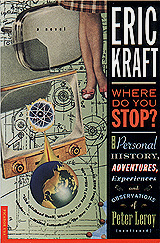

| Where Do You Stop?
Chapter 11: The Powerfully Disturbing Effect of Discontinuity |
by Eric
Kraft, as Peter
Leroy
|

YOU CAN READ THE FIRST THIRD
YOU CAN BUY THE
|
Discontinuity can have a powerfully disturbing effect on the young mind, as a simple experiment demonstrates. (Caution: This experiment can be dangerous. For one thing, Step 1 can get you into some trouble, so it’s a good idea to prepare in advance a little speech on the value of science education and the experimental method.) You will need a candle, some fine white flour, a sharp knife, a metal punch or tin snips, a garden hose or other long rubber tube, and a large can with a lid. The best type of can is one in which potato chips are sold to institutions, such as the Purlieu Street School.
|
|||

Here are a couple of swell ideas from Eric Kraft's vivacious publicist, Candi Lee Manning: Tip the author.
Add yourself to our e-mailing list.
|
Where Do You Stop? is a work of fiction. The characters, incidents, dialogues, settings, and businesses portrayed in it are products of the author’s imagination and are not to be construed as real. Any resemblance to actual events or persons, living or dead, is entirely coincidental. Copyright © 1992 by Eric Kraft. All rights reserved. No part of this book may be reproduced or transmitted in any form or by any means, electronic or mechanical, including photocopying, recording, or by any information storage and retrieval system, without permission in writing from the author. Where Do You Stop? was first published in hardcover by Crown Publishers, Inc., 201 East 50th Street, New York, New York 10022. Member of the Crown Publishing Group. YOU CAN BUY THE
For information about publication rights outside the U. S. A., audio rights, serial rights, screen rights, and so on, e-mail the author’s imaginary agent, Alec “Nick” Rafter. The illustration at the top of the page is an adaptation of an illustration by Stewart Rouse that first appeared on the cover of the August 1931 issue of Modern Mechanics and Inventions. The boy at the controls of the aerocycle doesn’t particularly resemble Peter Leroy—except, perhaps, for the smile. |
|
||||||
| . | . |